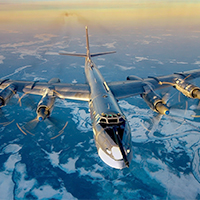Two pilots killed in Tu-95 crash

Six Russian military aircraft of different designs have crashed since the start of June as the country’s air force buckles under the strain of the Kremlin’s efforts to show off its military power.
The latest accident came on Tuesday, when a Tu-95 strategic bomber went down in Russia’s Far East. All four of its engines had failed mid-flight during a training mission, an unidentified government source told news agency TASS.
Five of the airmen aboard the crashed Tu-95 managed to successfully bail out of the aircraft, while the two remaining crew members died, news agency Interfax reported later.
The bombers, known in the Russian air force as “Bear” aircraft, form the mainstay of Russia’s long-range bomber fleet, with around 60 in service. Other Russian bombers include the long-range supersonic Tu-160, and the shorter range supersonic Tu-22M.
Tuesday’s crash was the second loss of a “Bear” in just over one month. Four fighter jets have gone down in the same period.
The core problem driving Russian planes into the ground at such an astonishing rate is the air force’s heightened tempo of patrols and exercises since the start of the Ukraine crisis 18 months ago, aerospace experts told The Moscow Times.
Last year NATO intercepted 400 Russian aircraft near its borders, a 50 percent increase over 2013. Russian aircraft are being dispatched to test the alliance’s reaction times in the Baltic, in Western Europe, and even along the west coast of North America. But these missions are burning the old birds out.
“Russian aircraft were never designed for maintainability, they were designed to be flown 10 years and then thrown away,” said Mark Bobbi, a principal analyst at international defense consultancy IHS.
Russia under President Vladimir Putin in 2010 launched a massive 20 trillion ruble ($350 billion) rearmament program intended to replace 70 percent of Russia’s aging hardware with brand new equipment by the end of the decade, but the modernization drive for Russia’s air force appears to be falling behind the Kremlin’s ambitions on the international stage.
“Even with the big budgets of the past 10 years, Russia has not been able to recapitalize its fleet fast enough to get ahead of the age-out curve; the point of no return when an aircraft should not be flown any longer and the risk of accident is magnified,” he added.
A source close to the Defense Ministry said on condition of anonymity that the pilot training also factors into Russia’s string of aircraft losses.
“Many pilots in Russia today are young or lack flying experience,” the source said, pointing out that Russia has only recently begun to purchase advanced computer simulators to give young pilots more practice before entering their cockpits.